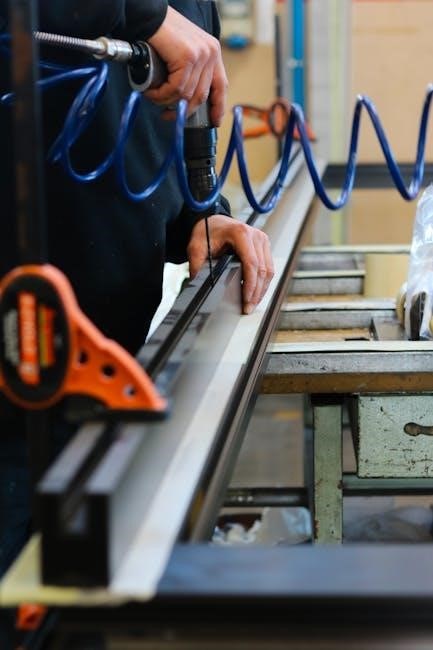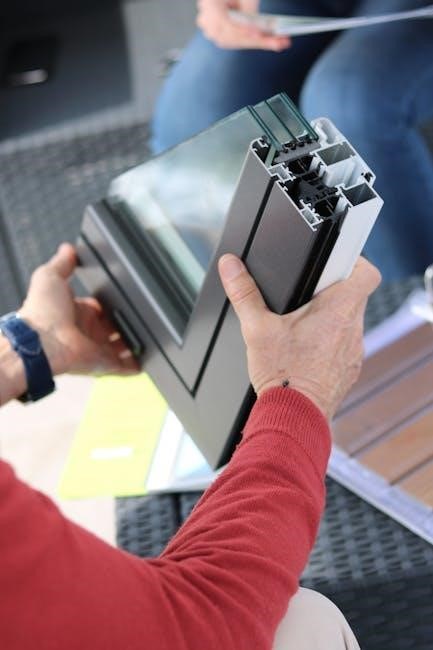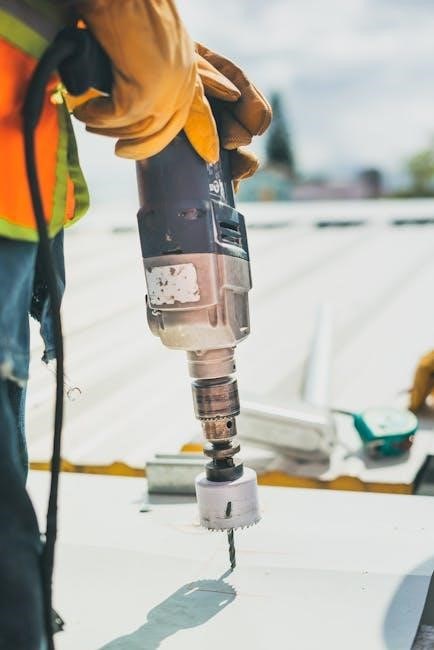August Wilson’s Fences is a powerful exploration of race, family, and the American Dream, set in 1950s Pittsburgh. The play follows Troy Maxson’s struggles and legacy.
1.1 Overview of the Play
Fences by August Wilson is a poignant drama set in 1950s Pittsburgh, exploring themes of race, family, and the American Dream. The play centers on Troy Maxson, a complex, often conflicted patriarch, and his fractured relationships with his wife, Rose, and son, Cory. Troy’s past as a Negro League baseball player and his present struggles as a sanitation worker underscore his bitter disillusionment. The titular fence symbolizes emotional barriers and the quest for protection and unity. Through vivid dialogue and rich characterization, Wilson examines generational trauma, identity, and the enduring impact of societal oppression.
1.2 Historical Context of the Play
Fences is set in 1950s Pittsburgh, a period marked by racial segregation and limited opportunities for African Americans. The play reflects the societal challenges of the time, including discrimination in employment and housing. Troy Maxson’s experiences as a Negro League baseball player and his eventual work as a sanitation worker highlight the systemic barriers faced by Black Americans. The play also touches on the Great Migration and the gradual decline of the Negro Leagues as Major League Baseball began integrating. Wilson uses this historical backdrop to explore themes of identity, resilience, and the struggle for equality during a transformative era in American history.

Themes in “Fences”
Central themes include the elusive American Dream, racial identity, and family dynamics, exploring Troy’s struggles and their impact on his relationships and legacy.
2.1 The American Dream
The American Dream is a central theme in Fences, symbolizing hope and equality. Troy Maxson’s aspirations for a better life are hindered by systemic racism and economic inequality, reflecting the broader struggles of African Americans in the mid-20th century; His inability to achieve this dream leads to frustration and resentment, affecting his relationships, particularly with his son Cory. Wilson critiques the illusion of equal opportunity, highlighting how societal barriers prevent many from attaining true prosperity and fulfillment.
2.2 Race and Identity
Race and identity are pivotal in Fences, exploring the struggles of African Americans in 1950s America. Troy Maxson’s experiences with racism and discrimination shape his worldview, fostering a deep-seated bitterness. His identity is marked by resilience and pride, yet also by the scars of segregation and oppression. Rose’s character offers a contrasting perspective, emphasizing strength and community. The play delves into the internal conflicts of identity, highlighting how societal racism impacts personal and familial relationships. Wilson masterfully portrays the complexities of Black identity, weaving historical and cultural nuances into the narrative.
2.3 Family Dynamics
Family dynamics in Fences are complex and fraught with tension. Troy’s relationship with his sons, Cory and Lyons, reflects his own fractured upbringing. His strict, often harsh parenting stems from a desire to shield them from the hardships he endured. Rose, as the emotional anchor, strives to mediate and maintain family unity. The play examines themes of generational conflict, paternal responsibility, and the consequences of unresolved emotional wounds. Wilson portrays a family grappling with love, betrayal, and the struggle for understanding, highlighting the enduring impact of past traumas on present relationships.

Characters in “Fences”
Fences revolves around Troy Maxson, a complex, flawed patriarch, and his family. Key characters include Rose, Troy’s wife, and Cory, their son, whose tensions with Troy drive the narrative.
3.1 Troy Maxson
Troy Maxson is the central figure in Fences, a complex man grappling with his past and societal expectations. His experiences as a Black man in 1950s America shape his identity and decisions. Troy’s relationship with his family, particularly his son Cory, is fraught with tension and misunderstanding, reflecting his internal struggles. His character embodies both strength and flaws, making him a deeply human and relatable figure in August Wilson’s exploration of race, family, and the American Dream.
3.2 Rose Maxson
Rose Maxson, Troy’s wife, is a pillar of strength and resilience in Fences. She embodies patience and endurance, navigating the challenges of her marriage and family life with quiet determination. Rose’s unwavering commitment to her loved ones, particularly her son Cory, highlights her nurturing nature. Her relationship with Troy is complex, marked by both loyalty and unspoken pain. Rose’s character serves as a moral compass, offering emotional stability amidst the turmoil of her household. Her resilience and grace make her a pivotal figure in the play’s exploration of family dynamics and racial identity.
3.3 Cory Maxson
Cory Maxson, Troy and Rose’s son, represents the next generation’s struggle with identity and ambition in Fences. His father’s disapproval of his football aspirations creates tension, highlighting generational conflicts. Cory seeks validation and understanding, often feeling stifled by Troy’s rigid expectations. His journey reflects the challenges of balancing personal dreams with familial obligations. Cory’s character underscores themes of sacrifice and the quest for self-determination, making him a pivotal figure in the play’s exploration of family dynamics and racial identity in 1950s America.
Symbolism in “Fences”
In Fences, symbols like the fence and baseball metaphorically explore themes of division, protection, and missed opportunities. These elements reflect Troy’s internal struggles and societal barriers.
4.1 The Fence as a Symbol
The fence in August Wilson’s Fences symbolizes both division and protection. Troy builds it to shield his family, yet it also isolates him emotionally. The fence represents his conflicting desires for security and freedom, reflecting the barriers he constructs around himself. It embodies the tension between inclusion and exclusion, physically and metaphorically. Through the fence, Wilson explores themes of confinement, responsibility, and the elusive American Dream. The fence becomes a poignant metaphor for Troy’s internal struggles and the societal fences that constrain him.
4.2 Baseball as a Metaphor
Baseball in Fences serves as a powerful metaphor for Troy Maxson’s life and aspirations. His missed opportunity to join Major League Baseball symbolizes the racial barriers and lost dreams of his generation. The sport represents both escape and exclusion, reflecting Troy’s internalized bitterness. Through baseball, Wilson explores themes of opportunity, failure, and the elusive American Dream. Troy’s prowess on the field contrasts with his struggles off it, highlighting his complex relationship with success and identity. Baseball becomes a metaphor for life’s challenges, victories, and the fences that society constructs around African Americans.
Critical Reception and Analysis
Fences received widespread acclaim for its profound portrayal of African-American experiences. Critics praised its emotional depth, complex characters, and exploration of race and identity, solidifying its legacy.
5.1 Reviews and Accolades
August Wilson’s Fences garnered widespread critical acclaim, earning the Pulitzer Prize for Drama in 1987. Critics praised its emotional depth, vivid dialogue, and powerful exploration of race and identity. The play was hailed as a landmark in American theater, with Troy Maxson becoming one of Wilson’s most iconic characters. Broadway productions, including the 2010 revival starring Denzel Washington, received rave reviews. The play’s success underscored Wilson’s mastery of storytelling, cementing Fences as a cornerstone of African-American literature and a timeless classic in American drama.
5.2 Scholarly Interpretations
Scholars have extensively analyzed Fences, exploring its themes of race, identity, and family dynamics. Many interpret Troy Maxson’s character as a symbol of the African-American experience, reflecting the struggles of racism and personal responsibility. The play’s use of baseball as a metaphor for life has been widely studied, with scholars linking it to themes of opportunity and disillusionment. Researchers also examine the historical context of the 1950s, highlighting the play’s portrayal of societal barriers faced by African-Americans. These interpretations underscore Wilson’s ability to weave personal and collective histories into a powerful narrative.

August Wilson’s Legacy
August Wilson’s legacy endures through his profound impact on American theater and African-American literature, as seen in his powerful plays like Fences. His decade-by-decade exploration of African-American life remains influential.
6.1 Impact on American Theater
August Wilson’s Fences significantly shaped American theater by offering a raw, unfiltered portrayal of African-American life. His work earned a Pulitzer Prize and Tony Award, cementing his influence. Wilson’s plays, including Fences, are part of his groundbreaking 10-play cycle, each exploring a decade of African-American experience. His storytelling challenged stereotypes and brought diverse voices to the forefront. As a playwright and activist, Wilson advocated for Black theater, inspiring future generations. His legacy continues to resonate, making him a cornerstone of American theatrical history.
6.2 Contribution to African-American Literature
August Wilson’s Fences stands as a landmark in African-American literature, offering profound insights into the Black experience. It captures the complexities of race, identity, and family dynamics, resonating deeply with audiences. Wilson’s work challenges stereotypes, presenting authentic portrayals of African-American life. His exploration of historical and cultural themes has enriched the literary canon. Through Fences, Wilson gives voice to the struggles and triumphs of African-Americans, cementing his legacy as a pivotal figure in shaping the narrative of Black identity and culture in America.
PDF Resources for “Fences”
Various PDF resources, including study guides, summaries, and critical essays, provide in-depth analysis of Fences, aiding understanding of its themes, characters, and historical context.
7.1 Study Guides and Summaries
Study guides and summaries for Fences provide detailed overviews of the play’s plot, characters, and themes. These resources often include scene-by-scene analyses, character breakdowns,
and explorations of motifs like the fence and baseball. Many guides highlight August Wilson’s unique writing style and the historical context of the 1950s setting.
They also offer insights into key quotes, symbols, and discussions of the American Dream. PDF versions of these guides are widely available online,
making them accessible for students and scholars alike. These summaries are invaluable for understanding the play’s complexity and preparing for essays or exams.
7.2 Critical Essays and Analysis
Critical essays and analyses of Fences delve into the play’s deeper themes, such as the American Dream, racial identity, and family dysfunction. Scholars examine Troy Maxson’s complexities,
highlighting his struggles with masculinity and societal constraints. Essays often explore the symbolic significance of the fence and baseball, linking them to broader cultural themes.
Many analyses also address August Wilson’s contribution to African-American literature and his portrayal of the Black experience in the 20th century. PDF versions of these essays
offer in-depth critiques, providing valuable perspectives for academic research and literary study. These resources are essential for understanding the play’s layered meanings and impact.

Theatrical Performances and Adaptations
Fences has seen numerous stage productions and a notable film adaptation in 2016, starring Denzel Washington and Viola Davis, further cementing its impact on theater and cinema.
8.1 Stage Productions
August Wilson’s Fences has been widely performed on stage since its 1983 premiere at the Yale Repertory Theatre, directed by Lloyd Richards. The original Broadway production in 1987, starring James Earl Jones as Troy Maxson, earned critical acclaim and won multiple awards. Over the years, notable actors such as Denzel Washington and Viola Davis have brought the characters to life in various revivals. The play’s powerful dialogue and emotional depth continue to resonate with audiences, solidifying its place as a cornerstone of American theater. Its stage success highlights Wilson’s mastery of storytelling and cultural resonance.
8.2 Film Adaptations
In 2016, Fences was adapted into a film directed by Denzel Washington, who also starred as Troy Maxson. The movie, produced by Paramount Pictures, received widespread critical acclaim. Viola Davis reprised her Tony-winning role as Rose Maxson, earning an Academy Award for Best Supporting Actress. The film stayed faithful to Wilson’s original play, capturing its emotional intensity and themes of family and identity. Its success introduced the story to a broader audience, further cementing the play’s legacy in both theater and cinema. The adaptation underscored the timeless relevance of Wilson’s work.































































